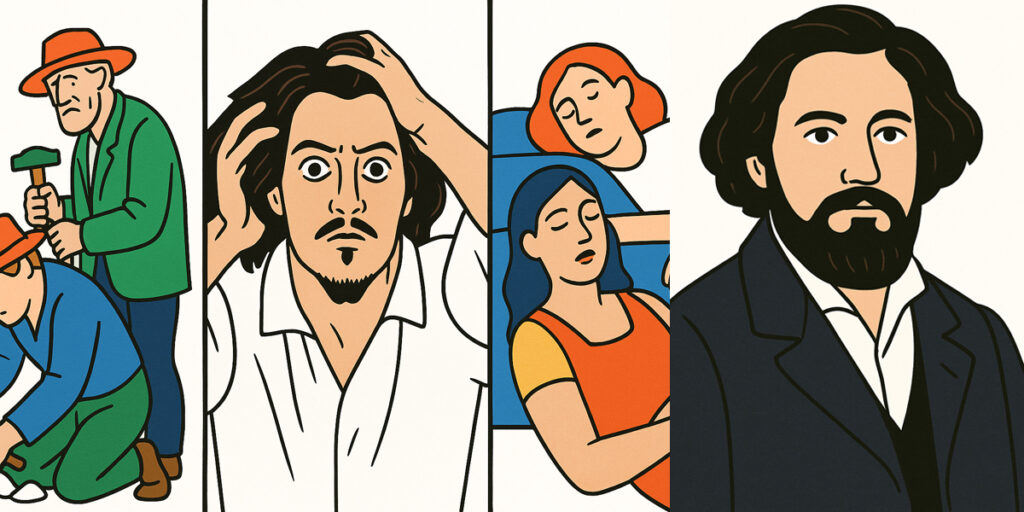Gustave Courbet was born to change the rules of art. He did not follow the glittering beauty of myths or the heroic stories of kings and angels. Instead, he looked at the world around him — its people, its pain, its truth — and painted it with honesty so bold that the world had to pause and take notice. He was not just an artist. He was a fire of freedom, burning through the polished canvas of tradition with a brush dipped in reality.
Born in the quiet town of Ornans in eastern France, Courbet grew up surrounded by fields, forests, workers, and everyday life. From a young age, he carried inside him a storm of confidence. While others dreamed of fame through elegance, he believed greatness could bloom in mud, in muscles, in the sorrow etched on a laborer’s brow. He believed art should not lie. And with that belief, he shaped one of the boldest movements in art history — Realism.
Courbet was not born in a palace, nor did he move in royal circles. He was the son of a wealthy farmer, and he carried the strength of the soil in his soul. His early works were raw and powerful, portraits of real people — not idealized versions, but as they were. Strong jaws, tired eyes, hands dark with labor. He dared to show the world what others chose to ignore.
One of his most groundbreaking works, The Stone Breakers, shows two men breaking stones on the roadside. One young, one old. Both locked in the rhythm of endless toil. Their clothes are torn. Their bodies are bent. There is no glory, no escape — just the simple truth of survival. This painting was not meant to decorate a ballroom. It was a mirror held up to society. Courbet was telling the world: Look. Look at what you refuse to see.
He painted without fear. He painted with love for truth. That love led him to A Burial at Ornans — a monumental piece showing the funeral of a common man in his hometown. There were no divine rays from heaven. No angels weeping. Just ordinary people, standing in black, faces still with grief. The painting was massive, as large as history paintings meant for gods and heroes. But this was a hero of the earth — a man who lived and died like so many others. Courbet lifted the common man to the walls of the museum, declaring his life worthy of respect.
The critics were outraged. How could such plain scenes be called art? Where was the beauty? Where was the fantasy? But Courbet was not here to please them. He once said, “I am not an angel painter.” And he stayed true to that spirit all his life.
As his fame grew, so did his defiance. He refused the French Legion of Honour — a medal many would have begged for. He said, “I refuse to accept an award from a government I disagree with.” This was not rebellion for the sake of pride. This was a man whose soul belonged to the people. A man who believed that truth was the highest honor of all.
Courbet was not a lonely figure in a studio. He was a fighter in the streets of Paris. When revolution sparked and the people rose, he stood beside them. During the Paris Commune, he took a role in protecting art and national treasures. He opposed the destruction of public buildings but was later blamed for the fall of the Vendôme Column — a symbol of imperial power. The government punished him harshly. He was imprisoned. His art was seized. His name was thrown into dust.
But even in exile, his spirit did not break. He moved to Switzerland, carrying with him memories of both glory and ruin. He kept painting, kept speaking, kept dreaming. Even when illness wrapped around him, his passion did not fade. His final years were quieter but still carried the fire of his youth.
Gustave Courbet was more than a painter. He was a poet of the people, a sculptor of truth, a builder of bridges between reality and canvas. He taught the world to find dignity in the soil, in the sweat, in the everyday stories that breathe around us.
He died in 1877, far from his homeland, but his work remained. It whispered into the ears of future painters, inspired the hands of those who dared to defy beauty’s shallow mask, and gave courage to artists who believed in the sacred power of truth.
Today, when we look at his paintings, we do not just see figures. We see a revolution. We see the trembling dignity of a man who stood for what he believed — not with swords or speeches, but with color, with texture, with honesty.
He reminds us that art is not just decoration. It is declaration.
Gustave Courbet lives not in marble statues or golden frames but in every brushstroke that dares to tell the truth. He turned pain into poetry, labor into legend, and reality into rebellion. He did not wait for history to accept him — he walked straight into its heart and planted his flag.
And there it stands still.
The Stone Breakers
Two laborers, one old and one young, bend over their endless task, breaking stones on the roadside. This masterpiece breaks the silence around poverty and hardship. Courbet does not soften the truth. He elevates it. He transforms sweat into sacred ink and writes the dignity of labor on a grand canvas. The work roars with the strength of those who survive without applause.
A Burial at Ornans
An enormous painting of a simple funeral in a small town. It refuses to romanticize death. Instead, it honors the quiet sorrow of ordinary people. Every face tells a story. Every figure stands tall with realism. Courbet gives the common man a place in art history with a voice as deep as the cathedral bells of grief. This is not mourning. It is majestic remembrance.
The Desperate Man
A self-portrait that screams from the soul. Wide eyes, wild hair, hands clutching his head — the face of a man pushed to the edge. It is not just Courbet’s fear. It is all our moments of inner chaos captured in pure paint. This work proves that courage is not found in calm but in facing storms without pretending they don’t exist.
Young Ladies on the Banks of the Seine
Two women rest by the river. They are not royal. They are not idealized. They are real, relaxed, and grounded in their own freedom. Their beauty is not in perfection but in presence. Courbet challenges every rule of feminine depiction in art and replaces illusion with truth. He paints women not as objects, but as humans living their own stories.
The Painter’s Studio: A Real Allegory
A giant painting of his own life, filled with friends, workers, children, animals, and even enemies. At the center, Courbet paints himself — working, not posing. This is his manifesto in oil. His statement to the world: Art is not just imagination. It is life itself. This is a tribute to the creative force that dares to shape reality rather than escape from it.
The Sleepers
Two women wrapped in sleep, peaceful and fearless. Their embrace is natural and filled with trust. This painting whispers of intimacy without spectacle. It respects silence. Courbet captures the soft power of rest and affection. There is no performance, only presence. It is an ode to human connection, painted with courage and tenderness.
Self-Portrait with Black Dog
A young Courbet stands confidently, a black dog by his side. He looks out with clarity and charm, already holding a bold identity. The dog is loyalty. The look is purpose. This portrait breathes ambition, the early echo of an artist ready to carve new paths through the wilderness of tradition.
The Wounded Man
A symbolic self-portrait filled with poetic sorrow. A man lies with a wound in his chest, his beloved gone, his heart bleeding into the ground. This is not weakness. This is beauty in pain. Courbet paints vulnerability without shame. He shows us that even broken hearts can be turned into brushstrokes of bravery.
The Wave
A series of seascapes that capture the raw power of water. Courbet’s waves are alive — they crash, curl, and explode. He does not tame the ocean. He celebrates its wildness. These paintings are more than landscapes. They are lessons in embracing force and change. They speak of nature’s thunder, echoing the spirit of freedom.
The Deer in the Forest
A quiet deer stands alert in the shadows of trees. It is hunted, maybe wounded. But it is still proud. Still part of the wild. Courbet reminds us through this gentle creature that grace lives in the woods, in fear, in instinct, and in the still moments before flight. Even silence can carry the weight of survival.
The Hammock
A woman swings in a soft hammock, surrounded by green. Time seems to pause. There is rest here, and laughter not yet heard. This work is a lullaby in paint. Courbet celebrates simple joys — the pause, the breeze, the breath. It teaches us to value the moments between noise, to find magic in the ordinary.
The Source of the Loue
A painting of a river springing from rock — rough, real, and eternal. There’s no myth here, just truth and movement. The water speaks of beginnings. The stone speaks of strength. Courbet paints geography with soul. It is nature’s autobiography, told with brush and reverence.
The Hunt Breakfast
Men and animals gather around food after a hunt. It’s not grandeur. It’s human. Laughter, hunger, tiredness — all painted with richness and earthiness. Courbet gives even meat and mud a voice. This painting says: there is art in appetite. There is beauty in the shared meal, in the ritual of togetherness.
Jo, the Beautiful Irish Girl
A portrait bursting with quiet confidence. Her gaze is fearless. Her red hair burns like a torch of individuality. Courbet does not hide her reality — he reveals her charm, her presence. It is a love letter to spirit and strength, not to fantasy.
The Oak of Flagey
An old oak tree stands tall in the land of Courbet’s childhood. It is gnarled, rough, and glorious. Like the artist himself. This painting is rooted in memory and pride. The tree is a monument to origin, a tribute to home. It shows that what grows from deep soil can stand through storms.
Gustave Courbet’s body of work is more than a collection of paintings. It is a library of truth, a song for the unnoticed, a celebration of the authentic. He teaches us not to look away, but to see deeper. Not to idealize, but to honor. Each painting is a candle lit for courage, for resistance, and for the real stories that shape the human world.


